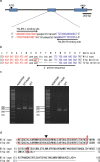In vivo functional characterisation of pheromone binding protein-1 in the silkmoth, Bombyx mori
- PMID: 30202026
- PMCID: PMC6131395
- DOI: 10.1038/s41598-018-31978-2
In vivo functional characterisation of pheromone binding protein-1 in the silkmoth, Bombyx mori
Abstract
Male moths detect sex pheromones emitted by conspecific females with high sensitivity and specificity by the olfactory sensilla on their antennae. Pheromone binding proteins (PBPs) are highly enriched in the sensillum lymph of pheromone sensitive olfactory sensilla and are supposed to contribute to the sensitivity and selectivity of pheromone detection in moths. However, the functional role of PBPs in moth sex pheromone detection in vivo remains obscure. In the silkmoth, Bombyx mori, female moths emit bombykol as a single attractive sex pheromone component along with a small amount of bombykal that negatively modulates the behavioural responses to bombykol. A pair of olfactory receptor neurons, specifically tuned to bombykol or bombykal, co-localise in the trichodeum sensilla, the sensillum lymph of which contains a single PBP, namely, BmPBP1. We analysed the roles of BmPBP1 using BmPBP1-knockout silkmoth lines generated by transcription activator-like effector nuclease-mediated gene targeting. Electroantennogram analysis revealed that the peak response amplitudes of BmPBP1-knockout male antennae to bombykol and bombykal were significantly reduced by a similar percentage when compared with those of the wild-type males. Our results indicate that BmPBP1 plays a crucial role in enhancing the sensitivity, but not the selectivity, of sex pheromone detection in silkmoths.
Conflict of interest statement
The authors declare no competing interests.
Figures



Similar articles
-
Targeted disruption of a single sex pheromone receptor gene completely abolishes in vivo pheromone response in the silkmoth.Sci Rep. 2015 Jun 5;5:11001. doi: 10.1038/srep11001. Sci Rep. 2015. PMID: 26047360 Free PMC article.
-
Pheromone-binding proteins contribute to the activation of olfactory receptor neurons in the silkmoths antheraea polyphemus and Bombyx mori.Chem Senses. 2004 Feb;29(2):117-25. doi: 10.1093/chemse/bjh012. Chem Senses. 2004. PMID: 14977808
-
A pheromone-binding protein mediates the bombykol-induced activation of a pheromone receptor in vitro.Chem Senses. 2006 Jul;31(6):547-55. doi: 10.1093/chemse/bjj059. Epub 2006 May 5. Chem Senses. 2006. PMID: 16679489
-
Molecular and neural mechanisms of sex pheromone reception and processing in the silkmoth Bombyx mori.Front Physiol. 2014 Mar 31;5:125. doi: 10.3389/fphys.2014.00125. eCollection 2014. Front Physiol. 2014. PMID: 24744736 Free PMC article. Review.
-
Molecular mechanisms underlying sex pheromone production in the silkmoth, Bombyx mori: characterization of the molecular components involved in bombykol biosynthesis.J Insect Physiol. 2007 Aug;53(8):752-9. doi: 10.1016/j.jinsphys.2007.02.014. Epub 2007 Mar 6. J Insect Physiol. 2007. PMID: 17448494 Review.
Cited by
-
Sexual-biased gene expression of olfactory-related genes in the antennae of Conogethes pinicolalis (Lepidoptera: Crambidae).BMC Genomics. 2020 Mar 19;21(1):244. doi: 10.1186/s12864-020-6648-3. BMC Genomics. 2020. PMID: 32188403 Free PMC article.
-
Regulation of olfactory-based sex behaviors in the silkworm by genes in the sex-determination cascade.PLoS Genet. 2020 Jun 10;16(6):e1008622. doi: 10.1371/journal.pgen.1008622. eCollection 2020 Jun. PLoS Genet. 2020. PMID: 32520935 Free PMC article.
-
Molecular Characterization and Expression Patterns of Two Pheromone-Binding Proteins from the Diurnal Moth Phauda flammans (Walker) (Lepidoptera: Zygaenoidea: Phaudidae).Int J Mol Sci. 2022 Dec 26;24(1):385. doi: 10.3390/ijms24010385. Int J Mol Sci. 2022. PMID: 36613830 Free PMC article.
-
An Expanded Survey of the Moth PBP/GOBP Clade in Bombyx mori: New Insight into Expression and Functional Roles.Front Physiol. 2021 Oct 28;12:712593. doi: 10.3389/fphys.2021.712593. eCollection 2021. Front Physiol. 2021. PMID: 34776998 Free PMC article.
-
Crystal structure of Epiphyas postvittana pheromone binding protein 3.Sci Rep. 2020 Oct 1;10(1):16366. doi: 10.1038/s41598-020-73294-8. Sci Rep. 2020. PMID: 33004932 Free PMC article.
References
-
- Schneider D. 100 years of pheromone research: An essay on Lepidoptera. Naturwissenschaften. 1992;79:241–250. doi: 10.1007/BF01175388. - DOI
-
- Haupt, S. S., Sakurai, T., Namiki, S., Kazawa, T. & Kanzaki, R. Olfactory information processing in moths in The neurobiology of olfaction (ed. Menini, A.) 71–112 (CRC Press, 2009). - PubMed
Publication types
MeSH terms
Substances
Grants and funding
LinkOut - more resources
Full Text Sources
Other Literature Sources
Research Materials
Miscellaneous

